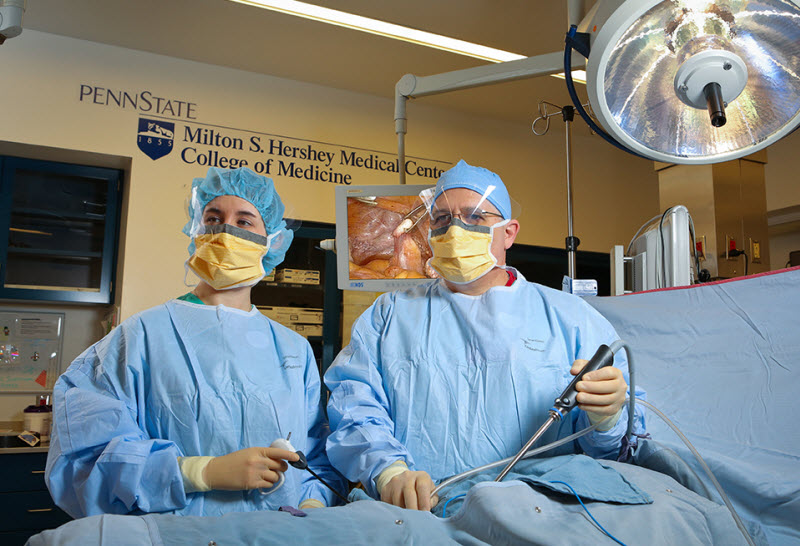Resident Training Program Emphasizes Minimally Invasive Hysterectomies: Achieving a New Standard of Patient Care
A residency training program that stresses minimally invasive hysterectomies is proving to be not only feasible, but a highly effective strategy for providing valuable surgeon training and improving patient outcomes. As leaders of Penn State Milton S. Hershey Medical Center’s Division of Urogynecology and Minimally Invasive Gynecologic Surgery, Gerald Harkins, M.D., and his colleague Matthew Davies, M.D., have closely tracked resident performance and patient outcomes. At the September 2013 Minimally Invasive Surgery Week and Endo Expo in Reston, VA, Harkins and his colleagues presented the first full twelve months of outcomes data from the training program. Among 537 patients who underwent hysterectomies for benign indications including abnormal bleeding, pelvic pain, fibroids, endometriosis, and prolapse/incontinence in a single year, 96 percent underwent minimally invasive surgery, either with vaginal or laparoscopic approach with a resident as the lead surgeon or the first assist, explained Harkins in an interview. Training new physicians and surgeons to provide up-to-date standards of care, including the use of minimally invasive techniques and robotic surgery, is a major challenge facing the health care field today. “Most physicians with established practices don’t have the necessary training in minimally invasive techniques, and so despite evidence that such techniques are safer and more cost-effective,1 60 percent of hysterectomies are still open procedures,” says Harkins. Recent nationwide OB/GYN residency training data suggest most U.S. trainees continue to lack needed minimally invasive surgical experience, with the average surgical resident completing sixty-four abdominal, eighteen vaginal, and twenty-three laparoscopic hysterectomies during training.2

Kristin Riley, M.D., fellow, assists Gerald Harkins, M.D. during minimally invasive gynecologic surgery. As part of its residency training program, residents act as lead surgeon or as first assist in 96 percent of the minimally invasive hysterectomy procedures at Penn State Milton S. Hershey Medical Center.
To directly meet this challenge, beginning in 2010, the department, in partnership with the American Association of Gynecologic Laparoscopists (AAGL), established a two-year fellowship program to train already-practicing physicians who want to learn minimally invasive techniques. According to Harkins, “We’re trying to achieve a paradigm shift for the OB/GYN field. Our residents and fellows have gone on to be leaders in minimally invasive gynecologic surgery in group practice settings after graduation. At the November AAGL meeting in Washington DC, program fellows Janis Green M.D. (‘12), and Timothy Deimling, M.D. (current fellow), presented the results of a randomized controlled trial comparing robotic hysterectomies with conventional laparoscopic hysterectomies, one of the few such trials completed in the country. The Penn State Hershey findings confirmed that safe and effective robotic surgical training programs can be implemented within the framework of a minimally invasive gynecologic surgery program with excellent patient outcomes. The key finding of the trial was that average robotic surgery operative time (90 minutes) was comparable to that with conventional laparoscopic surgery (88 minutes). This is the first study demonstrating equivalent surgical times and equivalent surgical outcomes with robotic versus conventional methods. The results of the study have been submitted for publication in the Journal of Minimally Invasive Gynecologic Surgery (JMIG). Harkins adds, “These data provide clear evidence of the value in training fellows and residents to perform minimally invasive hysterectomies. In my opinion, focusing on resident training is the most direct way to raise standards of care for the future, and to align everyday practice with technological advances.”
REFERENCES:
- Nieboer TE, Johnson N, Lethaby A, et al. Surgical approach to hysterectomy for benign gynaecological disease. Cochrane Database Syst Rev. 2009 Jul 8;(3):CD003677.
- Accreditation Council for Graduate Medical Education (ACGME), Case Log Statistical Reports, National Data 2009-2010. Available at: http://www.acgme.org/acgmeweb; accessed December 10, 2013.
